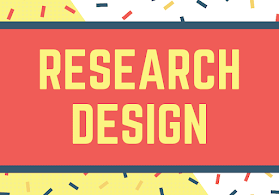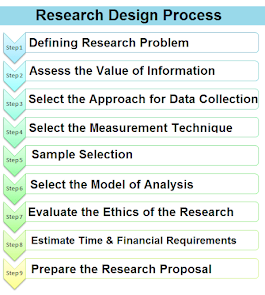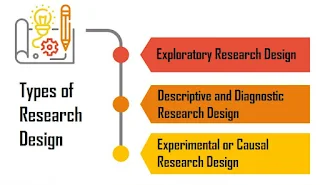What is Research Design ?
Research design refers to the overall plan and structure for conducting a research study, outlining the methods, procedures, and strategies to address the research questions or objectives effectively.
When a research is carried-out, it follows a definite pattern or plan of action throughout the procedure, i.e., since the problem identification to the report preparation and presentation. This definite pattern or plan of action is called "research design". It is a map that guides the researcher in collecting and analyzing the data. In other words, research design acts as a blueprint that is followed throughout the research work.
For example, a building cannot be constructed without the knowledge of its structure. A builder cannot order raw materials or set dates till he knows the structure of this building, such as office building, school, home, etc.
Definition of Research Design
According to William Zikmund :
"Research design is defined as a master plan specifying the methods and procedures for collection and analyzing the needed information."
According to Kerlinger :
"Research design is the plan, structure, and strategy of investigation conceived so as to obtain answers to research questions and to control variance".
According to Green and Tull :
"A research design is the specification of methods and procedures for acquiring the information needed. It is the over-all operational pattern or framework of the project that stipulates what information is to be collected from which sources by what procedures".
According to Selltiz et al. :
"A research design is the arrangement of conditions for collection and analysis of data in a manner that aims to combine relevance to the research purpose with economy in procedure".
A research design is not only a work plan, it also specifies the type of data required to address the research problem. It ensures that the data analysis and the conclusions, lead to answering the initial questions of researcher in a simple way. Therefore, at research design provides the structure of a research in such a way that it provides relevant outcomes economically.
Features of a Good Research Design
It is considered that a good research design should reduce the biasness while should maximize the reliability of data being collected and analyzed. A good research design should provide the opportunity as per the various aspects of research problem. It should minimize the experimental error and should provide maximum information. Hence, it can be concluded the selection of research design relies upon the research problem and the nature of research. Following are the major features of a good research design :
1) Objectivity :
Objectivity refers to the ability of the research instruments to give conclusions that are free from observer's personal biases. A good research design should be able select those instruments only that provide objective conclusions. Usually, it is believed that maintaining objectivity is pretty easy, but it proves to be difficult during execution of research and data analysis.
2) Reliability :
Another essential feature of a good research design is the reliability of responses. The instruments used in research should be able to provide similar responses to a question asked from a respondent. If the response varies, the instrument is considered unreliable. In other words, reliability of research design is measured in terms of consistency in responses.
3) Validity :
An important characteristic of a good research design is its ability to answer the questions in the way it was intended to. It should focus on the objective of the research and make specific arrangements or plan for achieving that objective.
For example, when a research is conducted to measure the effects of advertisements in viewers, it should be able to answer this, and not the sale of a particular product.
4) Generalizability :
A research design is said to be generalizable if the outcome of the research is applicable on a bigger population from which the sample is selected. A research design can be made generalizable by properly defining the population properly, selecting the sample carefully, analyzing the statistical data appropriately, and by preparing it methodologically. Therefore, the more the outcomes are generalizable, more efficient is the research design.
5) Sufficient Information :
Any research is conducted to gain insight of the hidden facts, figures and information. The research design should be able to provide sufficient information to the researcher so that he can analyze the research problem in a broad perspective. The research design should be able to identify the research problem and research objective.
6) Other Features :
Along with the above, there are some other features also that make a research design good. These are adaptability, flexibility. efficiency, etc. A good research design should be able to minimize the errors and maximize the accuracy.
Importance of Research Design
Purpose of research design / Use of research designs are as follows :
1) Reduces Cost :
Research design is needed to reduce the excessive costs in terms of time, money and effort by planning the research work in advance.
2) Facilitate the Smooth Scaling :
In order to perform the process of scaling smoothly, an efficient research design is of utmost importance. It makes the research process effective enough to give maximum relevant outcome in an easy way.
3) Helps in Relevant Data Collection and Analysis :
Research design helps the researchers in planning the methods of data collection and analysis as per the objective of research. It is also responsible for the reliable research work as it is the foundation for entire research. Lack of proper attention in preparation of research design can harm the entire research work.
4) Assists in Smooth Flow of Research Operations :
Research design is necessary to give better and effective structure to the research. Since all the decisions are made in advance, therefore, research design facilitates the smooth flow of research operations and reduces the possible problems of researchers.
5) Helps in Getting Reviews from Experts :
Research design helps in developing an overview about the whole research process and thus assists in getting responses and reviews from different experts in that field.
6) Provides a Direction to Executives :
Research design directs the researcher as well as the executives involved in the research for giving their relevant assistance.
Factors Affecting Research Design
Various factors that affect research design are as follows :
1) Research Questions :
Research questions perform an important role in selecting the method to carry-out research. There are various forms of research designs which include their own methods for collecting data.
For example, a survey can be conducted for the respondents to ask them descriptive or interconnected questions while a case study or a field survey can be used to identify the firm's decision-making process.
2) Time and Budget Limits :
Researchers are bound with restricted amount of time and budget to complete the research study. The researcher can select experimental or descriptive research when the time and budget constraints we favorable to him for the detailed study. otherwise exploratory research design can be adopted when the time is limited.
3) Research Objective :
Every research is carried out to obtain the results which help to achieve some objectives. This research objective influences the selection of research design. Researcher should adopt the research design which is suitable for research objective and also provides best solution to the problem along with the valuable result.
4) Research Problem :
Selection of the research design is greatly affected by the type of research problems. For example, the researcher selects experimental research design to find out cause and-effect relationship of the research problem. Similarly, if the research problem includes in depth study, then the researcher generally adopts experimental research design method.
5) Personal Experiences :
Selection of research design also depends upon the personal experience of researchers.
For example, the researcher who has expertise in statistical analysis would be liable to select the quantitative research designs. While, those researchers who are specialists in theoretical facets of research will be forced to select qualitative research design.
6) Target Audience :
The type of target audience plays very important role in selection of research design. Researcher must consider the target audience for which the research is carried-out. Audiences may either be general public, business professionals or government.
For example, if the research is proposed for general public, then the researcher should select qualitative research design. Similarly, quantitative research design would be appropriate for the researcher to introduce the report in front of the business experts.
Process of Research Design
The stages in the process of research design are interactive in nature and often occur at the same time. Designing of research study follows given process. Steps in research design :
Step 1: Defining Research Problem :
The definition of research problem is the foremost and important part of a research design process. Defining the research problem includes supplying the information that is required by the management. Without defining the research problem appropriately, it is not possible for the researcher to conclude the accurate, results. While defining research problem, the researchers first analyze the problems or opportunities in management, then they analyze the situation. The purpose of clarifying the research problem is to make sure that the area of concern for research is properly reflected and management decision is correctly described. After situation analysis, they develop a model for research which helps in the next step which is specification of information.
Step 2: Assess the Value of Information :
When a research problem is approached, it is usually based on some information. These data are obtained from past experiences as well as other sources. On the basis of this information, some preliminary judgement are made regarding the research problem. There is always a need for additional information which is available without additional cost and delay but waiting and paying for the valuable information is quite difficult.
For example, a car manufacturing industry may be concerned about decrease in the sale of a particular model. A researcher will look for the solutions by analyzing various aspects.
For this, the researcher has to continuously collect a lot of information and needs to evaluate them by understanding their value and filtering out useless information.
Step 3: Select the Approach for Data Collection :
For any type of research, a researcher needs data. Once, it is identified that which kind of information is required for conducting the research, the researchers proceed towards collecting the data. The data can be collected using secondary or primary sources.
Secondary data is the previous collected information for some other purpose, while the primary data is collected by the researcher especially for the research problem.
Step 4: Select the Measurement Technique :
After collecting data, the measurement technique for the collected data is selected. The major measurement techniques used in research are as follows :
i) Questionnaire :
Questionnaire is a formal structure which contains questions to collect the information from the respondents regarding his attitude, beliefs, behavior, knowledge, etc.
ii) Attitude Scales :
Attitude scales are used to extract the beliefs and feelings of the respondents regarding an object or issue.
iii) Observation :
It is the monitoring of behaviors and psychological changes of the respondents. It is widely used in research.
iv) Projective Techniques and Depth Interview :
Sometimes direct questions are not sufficient to get true responses from the individuals, that is why. different approaches like depth interviews and projective techniques are used. These techniques allow the respondents to give their responses without any fear. Researcher neither disagrees nor gives advice in these techniques.
Step 5: Sample Selection :
Once, the measurement technique has been selected, the next step is selecting the sample to conduct the research. The researchers in this stage select a sample out of the total population instead of considering the population as a whole. Sample can be selected by using two techniques, i.e., random sampling techniques, and non-random sampling techniques.
Step 6: Selecting Model of Analysis :
Researchers select the model of analysis or technique of data analysis, before collecting data. After this, researchers evaluate the techniques using hypothetical values to ensure that the measurement technique would provide the desired outcome regarding the research problem.
Step 7: Evaluate the Ethics of Research :
While conducting research, it becomes very much necessary for the researcher to follow ethical practices. The researches which are conducted ethically draws interests of general public, respondents, clients and other research professionals. Hence, it becomes the duty of the researcher to evaluate the practices in research, to avoid any biasness on behalf of the observer and researcher as well.
Step 8: Estimate Time and Financial Requirements :
This step is one of the most important steps in designing research. Here, researchers use different methods like Critical Path Method (CPM) and Program Evaluation Review Technique (PERT) to design the plan as well as control process and to determine the resources required.
A flowchart of these activities along with their approximate time is prepared for visual assessment of the research process. With the help of this chart, the researcher can find out the sequence of activities to be taken.
Step 9: Prepare the Research Proposal :
The final step in the process of research design is preparing the research proposal. A research proposal or the research design is prepared the operation and control of research. An effective research proposal is prepared before actual conduction of the research.
Types of Research Design
Based on the aim of study, there are three types of research design :
1) Exploratory Research Design :
Exploratory research design aims to get a better understanding of the problem by explaining the concepts and developing hypotheses regarding the research study. Various techniques used in exploratory research study are literature survey. surveys, focus groups, case studies, etc. Exploratory research does not emphasize upon sampling, but tries to gather information from participants who are considered knowledgeable.
2) Descriptive Research Design :
Unlike exploratory research, the aim of descriptive research is to describe the characteristics of a phenomenon is more rigid than exploratory research. It describes various aspects related to a population. It is the study that is designed to depict the population in much more accurate way. It attempts to describe, explain and interpret the conditions in much detailed approach. It examines a phenomenon that is occurring at a specific place and at specific time.
3) Experimental or Causal Research Design :
Experimental or Causal or Conclusive research design is a type of research design which is predetermined and structured in nature. It is used for causal or conclusive research, which is conducted quantitatively. It is called causal research, because it is helpful in exploring the cause and effect relationship of a research problem. The main objective of casual research is to test the hypotheses which were defined in the exploratory Research Design. Causal research is simply opposite to the descriptive research, as with the help of experimentation, it can interpret whether the relationship is causal or not.


